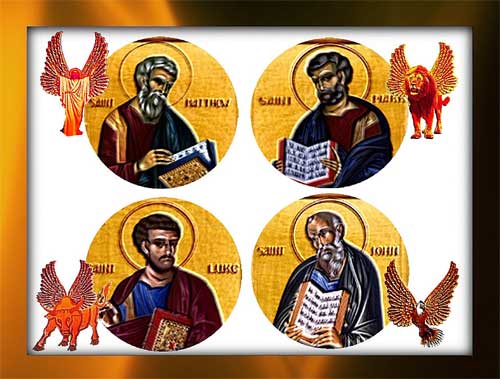(i) Allegory and The Gospels An introduction
An Overview of The Gospels : In this article we will discuss the traditional & mystical interpretation of the Gospels of the New Testament of the Bible. This will serve as an introduction to the articles which appear under the Bible section of this website which follow the symbolic and spiritual path that Christ taught, which has nothing to do with the Church or Religion.
(ii) The Gospels A Traditional Interpretation
 The four gospels are Matthew, Mark, Luke, and John. The word “gospel” (euangelion in Greek) means “good news.” The New Testament gospels tell the story of Jesus’ life, death, and resurrection and proclaim the good news of God’s victory over the powers of sin and death. Although the four gospels all tell the story of Jesus, each does so in a distinctive way, emphasizing particular aspects of Jesus’ identity and mission.(Bible Tutor).
The four gospels are Matthew, Mark, Luke, and John. The word “gospel” (euangelion in Greek) means “good news.” The New Testament gospels tell the story of Jesus’ life, death, and resurrection and proclaim the good news of God’s victory over the powers of sin and death. Although the four gospels all tell the story of Jesus, each does so in a distinctive way, emphasizing particular aspects of Jesus’ identity and mission.(Bible Tutor).
Sin has been extremely misunderstood by the church and has been responsible for much mental and physical abuse over the centuries.
So the traditional view is commonly one of a historic, literal series of events.
(iii) The Gospels A Mystical Interpretation
A more ‘spiritual’ interpretation of the Gospels identifies them as writings symbolic of the evolution of the soul. They deal primarily not with material things or persons, but with spiritual processes.Their object is not to give a historical account of the life of any man, but to demonstrate the spiritual potential within everyone from then until the present day.
The parables, being particularly obscure have been relatively untouched by rewriting over time. They contain important spiritual ‘gems’ which we will see when we look at the Gospels in detail over the coming weeks.
The book of St John : The Revelation is basically a communication from mans higher spiritual aspect to his lower self in order to get the soul back to God. Again this has been relatively unaltered due to its obscurity, and it is often avoided by the church as it cannot be understood unless someone has spiritually evolved. The same applies for the Gospels.
Taken literally the Bible as a whole becomes obscure, miraculous and nonsensical and relevant only to that period in history. But this is only an indication that they are SYMBOLIC in nature, relaying something universal to all man in a spiritual context.
(iv) The Gospels as Allegory
The allegorical nature of the Bible is found in the verse below with respect to the events of Abraham :
Galatians 4: 22 For it is written, that Abraham had two sons, the one by a bondmaid, the other by a freewoman.
4: 23 But he who was of the bondwoman was born after the flesh; but he of the freewoman was by promise.
4: 24 Which things are an allegory: for these are the two covenants; the one from the mount Sinai, which gendereth to bondage, which is Agar.
Allegory = As a literary device, an allegory in its most general sense is an extended metaphor. Allegory has been used widely throughout the histories of all forms of art, largely because it readily illustrates complex ideas and concepts in ways that are comprehensible to its viewers, readers, or listeners.
So in this instance, the Bible used the story of Abraham to convey the spiritual journey of the soul. This has been detailed in a previous article.
Psalms 78:2 I will open my mouth in a parable: I will utter dark sayings of old:
Only parables will be spoken. Words will be metaphors, not literal.
Dark sayings of old = for the Egyptians, darkness was the mystery of all mysteries & they refer to the spiritual mysteries within. He says ‘of old’ as these truths were known long before the time of Jesus. Krishna spoke about these mysteries 1000 years before Christ.
Finally St Paul said that by taking the Gospels and The Bible literally we are killing the spirituality of these scriptures and that they are found from within the heart (our spiritual heart) and not as ink on a page.
not with ink = an epistle of Christ does not occur through reading scriptures
2nd Corinthians 3 : 6 Who also hath made us able ministers of the new testament; not of the letter, but of the spirit: for the letter killeth, but the spirit giveth life.
not of the letter = ministers of the new testament are not those that read the Bible (not of the letter),
for the letter killeth = reading the Bible literally kills the spirit within.
but of the spirit = ministers are those that are connected to spirit which gives them life when they realise their immortality, and that spirit has never died & never been born.
(v) Conclusion
From the above we can have some authority from the Bile to move forward to interpret it symbolically and not as a literal series of events. In the next article we will demonstrate how the Gospels were represented astrologically in their original form and that orthodox Christianity has ignored this fact.

thanks so much. i would like to receive more of such articles to learn more